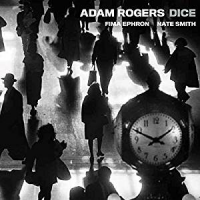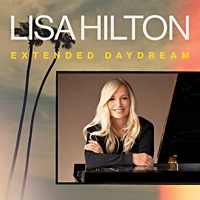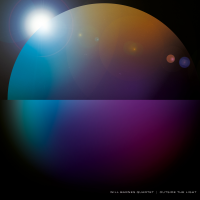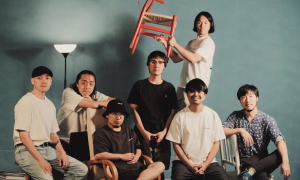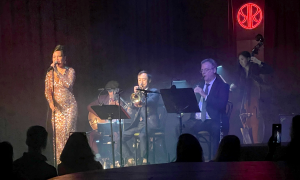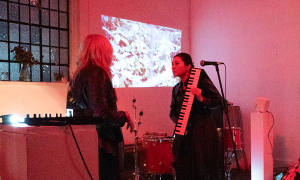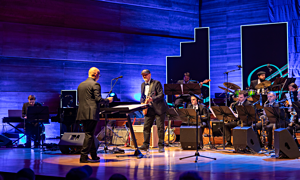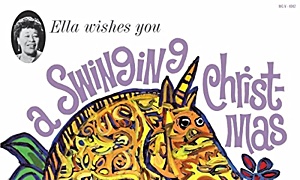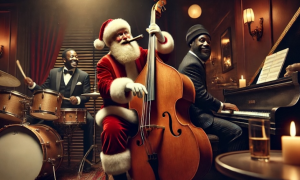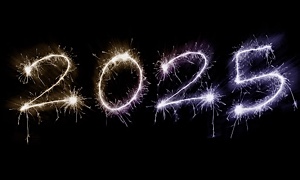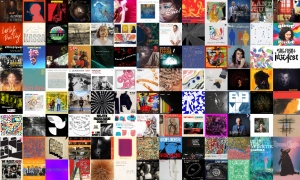Home » Jazz Articles » Live Review » King Crimson at Salle Wilfrid-Pelletier / Massey Hall
King Crimson at Salle Wilfrid-Pelletier / Massey Hall
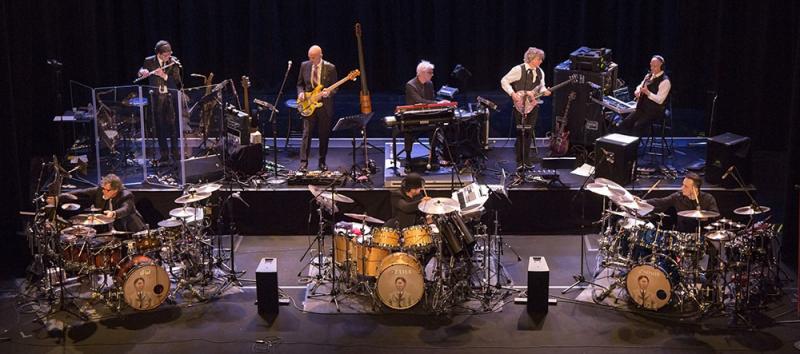
An Evening with King Crimson
Salle Wilfrid-Pelletier / Massey Hall
Le Festival International de Jazz de Montréal / Non-Festival Event
Montréal, Canada / Toronto, Canada
July 3, 2017 / July 5, 2017
Having covered the reunited, refreshed and reinvigorated "seven-headed Beast of Crim" for two nights each in San Francisco in 2014 and, again, in Montréal in 2015, was there really a good reason to see the group again in 2017...and, to make it even more complicated, in order to catch two evenings, traveling 540Km from Montréal—where the performed as part of Le Festival International de Jazz de Montréal—to Toronto?
In a word: yes. In more words: for many very, very good reasons.
First, the original, highly unconventional three-drummer front-line septet—featuring drummers Pat Mastelotto, Bill Rieflin (who also doubled on keyboards) and Gavin Harrison—alongside a back-line including reed-woodwind multi-instrumentalist Mel Collins, bassist/stick player/vocalist Tony Levin, guitarist/lead vocalist/flautist Jakko M. Jakszyk and only remaining member of the original formation that released the album that truly shook the rock world, In the Court of the Crimson King (Island, 1969), guitarist/keyboardist Robert Fripp—has now been dubbed the Double Quartet Formation with the addition of drummer/keyboardist Jeremy Stacey. Stacey already possessed an impressive résumé—ranging from jazzers like Tim Garland, Wayne Krantz, Jason Rebello and Tommy Smith to rock/pop stars including Joe Cocker, Noel Gallagher, Sheryl Crow and Eric Clapton, not to mention progressive rock artists like the late Chris Squire, Steve Hackett and the Squire/Hackett collaboration, Squackett—when he was asked to sub for the (thankfully) temporarily ill Rieflen during the group's 2016 European dates.
Fripp was clear, when Rieflin was forced to step away for a period of time, that should the drummer/keyboardist recover, his membership in the band would remain open. Still, Stacey had so impressed the guitarist and group that the decision was made not to simply thank him and hand him his walking papers. Instead, rather than becoming a four drummer-led front-line, Stacey has remained as one of the band's three drummers (and, like Rieflin, when he was on drums, occasional keyboardist), returning with a considerably larger drum set than that used throughout the 2016 dates, where he mirrored Rieflin's more minimalist kit in order to maintain the percussion section's overall complexion and Harrison's existing but ever-evolving arrangements. With Stacey remaining, the returning Rieflin changed locales to the back-line, where he became the band's first-ever full-time keyboardist...but he also took, whether or not it was intentional, a central position, situated between Collins and Levin to his right, and Jakszyk and Fripp to his left.
Second, while it was already well-known that the group's repertoire was too big for any single performance to contain, the material available to Crimson's 2017 North American tour has become so large that not even two nights could include everything the band was capable of playing; and that's with the understanding that, barring occasional festival appearances where time was restricted (thankfully, not so in Montréal), its performances consistently approached the three-hour mark, including a twenty-minute intermission between its two sets and three encores.
Third, in addition to many of the compositions already being performed by the septet lineup on tours between 2014 and 2016—reaching as far back as In the Court of the Crimson King, as far forward as its (so far) 2003 studio swan song, The Power to Believe (Sanctuary), and with enough new material now (as Jakszyk explained at a FIJM press conference the day of its July 3 Montréal show) to fill a pre-CD length album of 40 minutes—Crimson's 2017 North American dates included a significant amount of older material made (as Fripp has often described of this band's interpretations) new again that has not been previously experienced by North American fans.
To be crystal clear: King Crimson 2014-2017 is unequivocally not a tribute band, a legacy band or any other of the epithets applied to so many bands from back in the day that have reformed in recent times to capitalize on the burgeoning progressive rock revival of the past couple of decades. In fact, Crimson sits alongside Van der Graaf Generator as, perhaps, one of but a few bands of such longevity to not only reinvigorate its older material with a fresh approach, but to add new material that, with its own distinctive personality, fits as comfortably and with as much strength as the music that made it famous in the first place. And while VdGG remains a thrilling live act that has, out of necessity, been forced to rearrange its material for the trio version that emerged following co-founder David Jackson's departure after its 2005 comeback album Present (Virgin/Charisma, 2005) and accompanying tour, Crimson's approach to much of its 40+ year-old material— barring those where the signatures are so prevalent as to demand greater literalism—is far, far freer.
Fourth, since 2014 the lineup has included a couple of Fripp-penned instrumentals from the three-decade "Adrian Belew" years—when the charismatic guitarist/vocalist was a key member of Crimson incarnations from Discipline (E.G., 1981) through to the brief 2008 swan song tour, with Gavin Harrison added to The Power to Believe quartet lineup, documented on the download-only Park West, Chicago, Illinois August 7, 2008 (DGM Live, 2008)—specifically the high octane "VROOOM/Coda: Marine 475," from the Double Trio's sole full-length studio album, THRAK (Virgin, 1995), and the Nuevo Metal of The Power to Believe's "Level Five" and lighter but far knottier title track to the same Double Duo's 1999 Virgin Records debut, The ConstruKction of Light.
Now, however, two surprising vocal additions to the Double Quartet Formation's repertoire have been culled from Crimson's '80s re-emergence as a radically reinvented group, with three studio albums of a significantly altered complexion when compared to any of its late '60s/'early-to-mid-'70s incarnations. But, of course, beyond an eight-piece group expanding upon this material in ways Crimson's original quartet and sextet simply could not, Jakszyk's vocal interpretations of both songs also represented a radical departure...but more about that later.
Fifth—and by no means not just not least, but not even the final reason, but best to stop here for the moment—with Rieflin fulfilling the role of full-time keyboardist, and with Stacey and Fripp adding even more keyboards when required—the "seven-headed Beast of Crim" may have been the first live lineup ever capable of playing original studio material from across the decades without having to eliminate key compositional parts that were simply were impossible for its four, five and even six-piece incarnations. Now, however, this newly-minted Double Quartet Formation possesses even greater facility and latitude in bringing the multitude of original studio parts (or fresh interpretations of same) to the Crimson concert experience—as Fripp has always appropriately called them, "hot dates," in contrast to the "love letters" of its studio albums.
Between its Le Festival International de Jazz de Montréal show at Place des Arts' almost 3,000- seat Salle Wilfrid-Pelletier (a bump from the 2,200 capacity of 2015's Théâtre St-Denis) and performance, two nights later, at Toronto's legendary, 2,750-seat Massey Hall (a major leap from the Ontario capital's 1,250 capacity Queen Elizabeth Hall the same year)—in Montréal, Crimson included a full six tunes not heard previously during either its 2014 USA or 2015 Canadian tours (and one that has never been performed live prior to its 2016 dates); one brand new original; a David Bowie song (on which Fripp's silkily sustaining lines were an essential part of its fabric); a reworking of a song from 1970's In the Wake of Poseidon (Island, 1970), played on previous dates since 2015; and a new Fripp original introduced in 2014, but played just three times during its last Canadian tour. In Toronto, all of these pieces were also in the set list, barring the short track from Poseidon.
Two compositions from the often (and unfairly) overlooked Lizard (Island, 1970) were enough to engender eager anticipation from longtime Crimheads: the nightmare-inducing album-opener, "Cirkus," which was largely a consistent part of the Islands (Island, 1971) band's set lists back in the day, but which has never been performed live since; even more exciting, however, was the first-ever inclusion of the third movement from Lizard's side-long title suite: "The Battle of Glass Tears" (including "Dawn Song," "Last Skirmish" and the closing instrumental Fripp feature, the brooding "Prince Rupert's Lament"). Were these the only pieces added to the 2017 tour's potential set list (and both, so far, appear to be constants in every performance), North American fans would have been plenty satisfied. But that was not all; if fans had to deal with the absence of Islands' show-stopping "Sailor's Tale" in both cities, they could revel in the inclusion of another song that was played very occasionally during its original touring quartet's shows back in the day: the beautifully pastoral—and, in these turbulent times, particularly relevant—title track.
After a tacit understanding that there'd be no vocal tracks from the Belew years, it was especially surprising—and enticing—to discover what the Double Quartet Formation would do with two pieces culled from the '80s group recently collected on the 19-disc box set, On (and Off) The Road (Panegyric, 2016): Discipline's angular "Indiscipline" and, from the 1982 E.G. Records studio follow-up, Beat, the even more frenzied, beat poetry-inspired "Neurotica."
Finally, after performing three other songs from the '70s' final studio recording, Red (Island, 1974) and collected as part of the mammoth, 27-disc The Road to Red (Panegyric, 2013) box set on past tours beginning with its 2014 US return—the influential, instrumental title track; more song-based but still convention-busting "One More Red Nightmare"; and the lengthy piece that both closes the album and has wrapped most if not all Crimson main sets since 2014, "Starless"—the group has finally added the only other tune not previously played: the more balladic yet still powerful "Fallen Angel" (Red's only only other track, "Providence," was a completely free improv instrumental).
Performed on past tours but with Jakszyk singing Poseidon's "Peace: An End" in its entirety—on the live CD/DVD or CD/Blu Ray box set, Radical Action (To Unseat The Hold of Monkey Mind) (Panegyric, 2016), even singing the first verse in Japanese—Montréal fans were treated to a slightly reworked version where the first verse was played by Fripp with his appealingly smooth, seemingly infinitely sustaining tone, with Jakszyk playing the chordal accompaniment, before adding vocals from the second verse until the short song's end. Like "Islands," this is a song that maintains special relevance, again, in the unsettled political climate faced by so many.
Toronto may not have experienced "Peace: An End," a version of "Red" that, in Montréal and with Rieflin's keys adding more heft, was a particular highlight of a show filled with them, or Poseidon's metallic yet jazz-inflected "Pictures of a City"; but Montréal had to do without two seminal tracks from Larks' Tongues in Aspic (Island, 1973), also collected in the 15-disc box set, Larks' Tongues in Aspic (40th Anniversary Series Box) (Panegyric, 2012): the episodic "Larks' Tongues in Aspic, Part One," which moved between whispers and ear-shattering roars, as Fripp and Jakszyk traded complicated phrases and Collins contributed a mid-piece flute solo that, just as he did on Live in Toronto: Queen Elizabeth Theatre, November 20, 2015 (Panegyric, 2015), included a brief nod to Canada's national anthem; and the near-anthemic but still high octane, irregularly metered "Larks' Tongues in Aspic, Part Two."
Clearly, there have, indeed, been compelling reasons to see Crimson twice (at least) on any tour—though with the band still following its comfortable modus operandi of never performing on a travel day but changing its previous tactic of booking two or three nights in the same city, back-to-back, on previous tours since 2014, it became necessary to take the longer train ride to Toronto in order to do so. Still, as exhausting as it was, after covering five nights of the TD Ottawa Jazz Festival and, prior to Crimson's Montréal show, four previous evenings with five additional shows at Le Festival International de Jazz de Montréal, there truly was no choice for a longtime, committed Crimhead.
With plenty already written about the four shows in 2014 and 2015 by the then-current Crimson septet, there's little need to cover old ground. So, focusing on the material either new to the 2017 North American tour—or previously heard compositions where the addition of Rieflin as permanent keyboardist bore particular significance—while the Montréal show was, in a word, superb, the Toronto performance beat it out by a hair. Part of it was due to the rooms: as mentioned in the review of Québecois fusion trio Uzeb's return to action after a quarter-century hiatus, Place des Arts' Salle Wilfrid-Pelletier is a particularly boomy hall. Still, the front-of-house engineer did a good job at minimizing the boom but, as a result, the sound was more emphatic on the top end ("sizzly"), which meant that Levin was lower in the mix than he ought to have been. In Toronto, despite Mastelotto's comment, after the Montréal date, that Massey Hall was not a particularly good room for a rock band with three drummers (better-suited for symphonic purposes), the sound was, nevertheless, far better, and certainly better balanced.
On the other hand, as audiences go, Montréal was a generally more attentive (and, as ever, hugely enthusiastic) crowd. Toronto was marred by a nearby concert-goer who spent almost the entire concert texting; another group, seated a couple rows behind, provided ongoing commentary throughout most of the set, at a level that actually, at times, beat out the undeniably (but never uncomfortably) loud Crimson. And these are just two examples of an audience that, while certainly no less ardent, was overall noisier, seemingly less focused on what was in front of them and disturbing...especially during captivating quiet moments, where there was invariably someone who felt it necessary to scream out (and yes, in Toronto, someone did actually cry out "FREEBIRD!!!"). That's not to suggest the overall Toronto audience was bad; but there were far more disturbances going on that detracted from what was, indeed, a superior performance.
More disturbing, however, was the response of some members of both Montréal and Toronto audiences to the subject of photography and video/audio recording. Walking into both venues, fans were informed by ticket-takers that there was to be absolutely none of either; onstage, before the first set and during the intermission, two large signs reiterated the band's wishes; and prior to the first set, an unusually excited-sounding Fripp suggested that everyone "viddy with your eyes and record with your ears. Let's have a party," going on to say, as has been the rule since 2015, that at the end of the concert, when Levin typically shoots photos of the audience, the audience can also then photograph the band, after it had finished playing. And yet, in Toronto, no sooner did his pre-recorded announcement finish and the band began to walk onstage, a nearby woman picked up her cellphone and began snapping photos (though with a collection of people around her yelling "put down the effing cellphone," she at least acquiesced).
Still, throughout both Montréal and Toronto shows, occasional fans could be seen photographing and recording snippets of audio/video. Why—when artists make it so absolutely crystal clear that there is to be no photography, or audio/video recording—do supposed fans find it impossible to respect these wishes is a question for which there is a simple but unfortunate answer: for those people, a ticket is also considered an entitlement to do precisely what the band has requested they not do; and given what happened during one of Crimson's three Toronto performances in 2015—where, again, despite complete clarity on the subject, Fripp saw people ignoring the band's request and, consequently, cut "21st Century Schizoid Man" from the encore. Worse, of course, is that when such unfortunate situations occur, supposed fans tend to jump on Fripp and the band rather than the errant photographer(s) who, had he/she simply followed the group's simple instructions, would not have forced Fripp to make a decision that, no doubt, he'd have rather not had to make.
But back to the music. Toronto's performance may have been a slightly hotter date than in Montréal—Levin playing even more liberally than usual throughout the set but, in particular, during songs like "Cirkus," "Larks' Tongues in Aspic, Part Two," where he strayed from being an anchor to improvise more freely as he played the song with his "Funk Fingers" (two drum sticks, cut to shorter lengths and with rings that attach to his index and middle fingers), and during the middle section of "Starless," where he moved away from the signature riff while others kept it going. Collins was also even more impressive than during past tours, whether on alto, tenor or baritone saxophones or concert, alto or bass flutes; jazz man that he is, it's hard to know how many in the Toronto audience caught his quoting Duke Ellington's "Take the 'A' Train" during his solo in "21st Century Schizoid Man," but his baritone solos during both evenings' versions of "The Letters" managed to both adhere somehow to form while, at the same time, extending into even greater freedom and frenzy.
Jakszyk, too, took greater liberties as a guitarist throughout both sets—demonstrating, more than on previous tours, just how impressive an axe-slinger he is, such as managing to sing and combine both chordal accompaniment and some of Fripp's most mind-boggling acoustic phrases during "Cirkus," where the co-founding guitarist was busy on keys. His singing was, both evenings, quite simply, the best it's ever been since he became a band member with the 2014 lineup. On "Dawn Song," he was challenged to dig down into registers far lower than he'd ever reached before, and managed to do so with accuracy and, when required, strength. His voice was a thing of beauty on "Islands." And elsewhere, with songs like Bowie's "Heroes" (included on the Panegyric Heroes (Live in Europe) EP, released in May of this year), his delivery of both melodies and vocal improvisations during solo sections during Larks' Tongues in Aspic's "Easy Money," and his dramatic performance of "The Letters," with its now totally a cappella final verse, Jakszyk demonstrated both greater comfort and greater power at the upper end of his range.
But the biggest surprise of the evening, when it came to Jakszyk's vocals, came with his interpretations of "Indiscipline" and "Neurotica"—the latter, between Levin's stick playing and Stacey's potent kit work, actually swinging in a way it never did before. As Jakszyk briefly recounted after one of the shows, when Fripp suggested bringing these tunes into the current group's repertoire, he knew it would have been wrong to attempt replicating Belew's spoken word approach to much of these pieces. And so, with "Indiscipline," he created an oblique melody line, doubled on guitar and also featuring Levin on harmony vocals—and, rather than with the by-now somewhat iconic scream "I like it!," ending with a loud "J'aime ça!" (French for "I like it!") instead. The only time he sang during "Neurotica," on the other hand, was during its more melodic, groove-driven section. Ardent Belew fans may balk at this lineup's significant (blasphemous?) revisions to not just the vocals but the overall arrangements; but hasn't that always been the Crimson way? To revise, reinvent, reinvigorate...or, as John Cleese said, in an episode of Monty Python's Flying Circus, to "adopt, adapt and improve"?
And speaking of swing, there were a surprising number of moments where it was an element of the overall rhythmic fabric. Crimson may not be a jazz band by anyone's standard definition; but between its improvisational approach to even firmly structured pieces through individual interpretation and more open- ended pieces, including the two vocal tracks from the '80s, "The Letters" and the middle section of "Pictures of a City," King Crimson represents, perhaps more than any other group collected (and without ever considering itself as one) under the increasingly fixed rubric of 21st century progressive rock, a group with jazz attitude.
Stacey, with his larger kit, fit perfectly amidst the drum trifecta that also included Mastelotto and Harrison; but what was, perhaps, most revealing about all three drummers was how, with some of the newer material (and older material now brought into this Crimson's repertoire), there were passages where only one drummer carried the groove—and with, on some occasions, one of the others adding color and texture. Mastelotto, in particular, whose large "mad scientist" kit of drums—augmented with electronics and samples, but also all kinds of found objects—made him the closest equivalent any subsequent Crimson has had to the "X" factor that Jamie Muir brought to the quintet version of the Larks' Tongues in Aspic band. Harrison remained the most overtly virtuosic drummer of the three, in particular during his by-now regular extended solo during "21st Century Schizoid Man"; but on that front, neither Mastelotto nor Stacey were, by any stretch of the imagination, slouches either.
And when all three were playing Harrison's often complex yet still liberal arrangements— arrangements that defined clear roles, such as moving drum fills across the stage like runners passing the baton during a race, but not necessarily what each of them played—the three-drummer front- line was as compelling as ever, not just musically but visually. For a band where—barring a brief moment during "Starless" when the stage was drenched in, yes, red—there were no spotlights, no light show; instead, just a warmly lit stage, with everyone lit equally, including Fripp, and with eye contact and smiles aplenty...again, the guitarist included...it was a visual representation that echoed the philosophy of a group of equals, with no clear leader onstage (though, when it comes to decision-making, Fripp still retains veto power).
As for the three-drummer front-line? There still remain, three years after it began touring, naysayers to the concept; but the simple truth is, no matter how superb he absolutely was, even the great Bill Bruford—who participated in various Crimson incarnations from 1972 through 1997— would have been unable to accomplish, with a mere two hands and two feet, what this at-times 12-limbed single organism could...and did. It needn't be a matter of comparison; they're simply different.
Certain songs benefited from there being up to three keyboardists. Certainly, the Islands band's version of "Cirkus" was never as massive as when Rieflin, Stacey and Fripp were all contributing keyboard parts, ranging from symphonic mellotrons to acoustic and electric piano parts; the same applied to "Last Skirmish" where, despite there being fewer of the free jazz players that contributed to the studio version, this lineup managed to evoke all of its sheer power and evocative/provocative dramaturgy. Rieflin's role may not have always been obvious with eyes closed, as he contributed a broad array of textures, and melodic/chordal ideas; but watching him throughout the set, it was clear that he added plenty to the group, from sheer density to, at times, ethereal delicacy, rendering the complexion of songs even already heard during the 2014 and 2015 tours as new and, by definition, different.
It would appear that the two songs taken from the Jakszyk, Collins & Fripp album A Scarcity of Miracles (Panegyric, 2011)—the record that, also with the participation of Levin and Harrison, represented the seed of what would become the "seven-headed Beast of Crim" a couple of years later—have been dropped from the set. Who knows if they'll reappear...assuming Crimson, already a year past its original three-year plan, continues beyond 2017? And while there's a new vocal composition, "Radical Action III," that's been added to the obliquely titled "Radical Action (To Unseat the Hold of Monkey Mind)" and "Radical Action II"—this lineup's multi-version "Larks' Tongues in Aspic"?—only "Meltdown," a new vocal tune from 2015, along with "Radical II" and "Radical III" were included in the Montréal and Toronto set lists. Neither the original "Radical Action (To Unseat the Hold of Monkey Mind)" nor 2015's other compelling vocal tune, the irregularly metered, appropriately titled "Suitable Grounds for the Blues," were anywhere to be found. Only one of the percussion features, "Hell Hounds of Krim," was performed in Montréal, while Toronto also heard "Banshee Legs Bell Hassle."
The return of "Interlude"—a Fripp original that featured, in addition to the guitarist, Collins and Jakszyk on flutes, Levin on electric upright bass and, now, Rieflin on keys—has become a brief feature for the back-line, one with form, to be sure, but freedom as well. It may have almost gone by some of the fans as a mere, well, interlude, but remains one of the most beautiful, wonderfully understated miniatures that Fripp has written in recent years.
All of which leaves Fripp, the guitarist. Perhaps the only disappointment of both nights was the absence of the briefly revived "Fracture," not just the highlight of Starless and Bible Black (Island, 1974)—and, again, collected in an even more massive 31-disc/1-download box, Starless (Panegyric, 2014)—but one of Crimson's most challenging guitar pieces ever, performed during a handful of shows in 2016 and even fewer at the start of the 2017 tour. It may be, along with music from Lizard, one of the Crimson compositions that fans have been most eager to hear interpreted by either the seven or eight-piece band. At this point, the only hope is that it will be included in the upcoming live release...or, if not, then perhaps on a subsequent one.
But this disappointment aside, Fripp—like the rest of his band mates—performed with even greater freedom and improvisational élan than on any of the 2014-2016 tours. His solo during both nights' "Easy Money" drew rounds of applause. Jakszyk had expressed the hope, in a conversation back in 2015, that he'd be able to encourage Fripp to perform "Prince Rupert's Lament," an elegiac piece where Fripp's sustaining guitar lines are supported by a simple bass and mallet-driven tom tom ostinato; in Toronto, Jakszyk could be seen watching Fripp during the entire piece with a big smile on his face. Sometimes wishes can come true.
And, for any who've seen the group multiple times on multiple tours since Fripp brought Crimson back into active duty in 2013, in preparation for its first US tour since 2008, many, many dreams have come true.
With four-fifths of In the Court of the Crimson King and significant portions of In the Wake of Poseidon, Lizard and Islands being heard by fans for the first time since the '70s (for the younger ones, the first time ever); with all of Red's composed tracks available to the setlist and much of Larks' Tongues in Aspic; and selected pieces from Discipline, Beat, THRAK, The ConstruKction of Light and The Power to Believe also making appearances, what's most exciting about the current Double Quartet Formation of Crimson is, beyond its actual performances, that there is still plenty of material yet to be culled from all of those albums and more, along with an album's worth of new material already being performed and, hopefully more to come.
How long this version of King Crimson will continue is uncertain; but, then, isn't that true of the best things in life? Certainly, for fans of King Crimson's rich and varied discography and a lineup that clearly is the most enjoyable one Fripp has, for himself, put together since, perhaps, the group's very earliest days, with plenty of dreams already a reality, there are plenty more still to be fulfilled.
Photo Credit: Courtesy of DGM Live
Part 1 | Part 2
Tags
Live Reviews
King Crimson
John Kelman
Braithwaite & Katz Communications
Canada
Montreal
Pat Mastelotto
Bill Rieflin
Gavin Harrison
Mel Collins
Tony Levin
Jakko M. Jakszyk
Robert Fripp
Jeremy Stacey
Tim Garland
Wayne Krantz
Jason Rebello
Tommy Smith
joe cocker
Sheryl Crow
Eric Clapton
Chris Squire
Steve Hackett
Van der Graaf Generator
Adrian Belew
David Bowie
Uzeb
duke ellington
Jamie Muir
Bill Bruford
About King Crimson
Instrument: Band / ensemble / orchestra
PREVIOUS / NEXT
Support All About Jazz
 All About Jazz has been a pillar of jazz since 1995, championing it as an art form and, more importantly, supporting the musicians who make it. Our enduring commitment has made "AAJ" one of the most culturally important websites of its kind, read by hundreds of thousands of fans, musicians and industry figures every month.
All About Jazz has been a pillar of jazz since 1995, championing it as an art form and, more importantly, supporting the musicians who make it. Our enduring commitment has made "AAJ" one of the most culturally important websites of its kind, read by hundreds of thousands of fans, musicians and industry figures every month.




